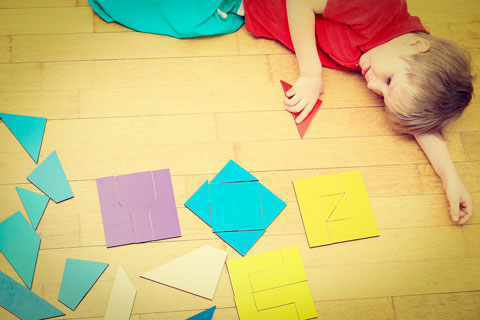There’s more to preschool math than counting! Classification skills are building blocks for learning important math concepts. Children classify objects, ideas, sounds, smells, or flavors into groups (categories) according to traits they have in common.
What do preschool children know about classifying?
Children ages 3-5 are learning to recognize colors, shapes, sizes, and materials. They are learning about parts and wholes. They can compare: biggest/smallest, more/less. They can sort by one trait at a time—separating blue buttons from red ones, for example. But sorting by both color and size might be difficult. Here are some ways to help children gain experience with classifying.
Make sorting a part of daily routines.
- Children can sort as they clean up (label shelves with pictures of the items they hold).
- Children can separate items to recycle.
- Children can “sort themselves” as a way to vote on classroom issues. “If you want to play outside, stand here. If you want to play in the gym, stand there.”
Play games that involve matching traits.
- Engage children in active games: “Mother May I” (involves categories of movement).
- Provide table games: Concentration, Go Fish, Bingo, Dominoes.
- Teach guessing games: “I hear something loud and rumbly. What is it?”
- Show children shoe search: Children take turns finding their own shoes in a pile.
- Introduce onomatopoeia, which is a word that sounds like the noise it describes (e.g., gargle, zap, pitter-patter).
- Match sounds to things you see: “When you see a cow in the storybook, say ‘Moo.’”
Offer other activities that involve classifying.
- Collections: Children can gather, display, and study related items.
- Object sorting: Children can use egg cartons or sheets of paper with two or more sections for grouping similar things—coins, tools, keys, shells, fabric pieces, plastic figures, pictures from catalogs. Explain, “For this activity, you can put things that are alike together.” When the child finishes, ask, “How are the ones in this group alike?”
- Parts and wholes: Children can cut clay shapes into pieces, match lids to containers, or put bolts and washers together.
Encourage children to observe and compare.
- Show children a familiar item and ask them to describe it. List the traits on an easel or chalkboard. Repeat with a similar item. Compare the lists. What is alike? Different? Introduce unfamiliar items. “Malik guesses this thing is made of wood. What makes you think so, Malik?”
- Describe things clearly. “Do you want a shiny pillow or a fuzzy pillow?” Use classification vocabulary: some, all, part, pair, set, category, observe, rule, different. Words for materials, sounds, smells, and flavors are useful, too.
IEL Resource
- Resource List: Math for Preschoolers


 PDF
PDF